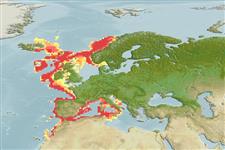Classification / Names
Common names from other countries
Main reference
Size / Weight / Age
Max length : 15.0 cm TL male/unsexed; (Ref. 1371); common length : 10.0 cm TL male/unsexed; (Ref. 1371); max. reported age: 3 years (Ref. 1371)
Environment
Marine; pelagic-oceanic; non-migratory; depth range 100 - 1000 m (Ref. 35388)
Climate / Range
Temperate, preferred ?; 74°N - 24°N, 18°W - 17°E
Distribution
Northeast Atlantic: found in the western Mediterranean and in the Atlantic around the Strait of Gibraltar and to the south along the Moroccan coast.
Countries | FAO areas | Ecosystems | Occurrences | Introductions
Short description
Dorsal
spines
(total): 0;
Anal
spines: 0. Eyes large; mouth oblique; chin barbel absent. Color varies from pink to light brown dorsally, silvery on sides and ventrally (Ref. 1371). Scales large, silvery and easily detached. Lateral line ends in 7 open mucus grooves on the upper side of the head (Ref. 35388).
IUCN Red List Status (Ref. 115185)
Threat to humans
Harmless
Human uses
Fisheries: minor commercial; bait: usually
More information
ReferencesAquacultureAquaculture profileStrainsGeneticsAllele frequenciesHeritabilityDiseasesProcessingMass conversion
Tools
Special reports
Download XML
Internet sources
Estimates of some properties based on models
Phylogenetic diversity index
PD50 = 0.7500 many relatives (e.g. carps) 0.5 - 2.0 few relatives (e.g. lungfishes)
Trophic Level
3.6 ±0.3 se; Based on diet studies.
Resilience
Medium, minimum population doubling time 1.4 - 4.4 years (K=0.19-0.50; tmax=3.0)
Vulnerability
Low to moderate vulnerability (25 of 100)
Price category
